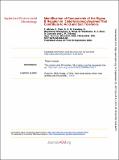| dc.contributor.author | Boyd, Aoife | |
| dc.contributor.author | Abram, Florence | |
| dc.contributor.author | Karatzas, Kimon-andreas | |
| dc.contributor.author | Matlawska-Wasowska, Ksenia | |
| dc.contributor.author | Connolly, David | |
| dc.contributor.author | O'Byrne, Conor P. | |
| dc.contributor.author | Starr, Emily | |
| dc.date.accessioned | 2013-11-29T12:29:05Z | |
| dc.date.available | 2013-11-29T12:29:05Z | |
| dc.date.issued | 2008-09 | |
| dc.identifier.citation | Abram, F,Starr, E,Karatzas, KAG,Matlawska-Wasowska, K,Boyd, A,Wiedmann, M,Boor, KJ,Connally, D,O'Byrne, CP (2008) 'Identification of Components of the Sigma B Regulon in Listeria monocytogenes That Contribute to Acid and Salt Tolerance'. Applied And Environmental Microbiology, 74 :6848-6858. | en_US |
| dc.identifier.uri | http://hdl.handle.net/10379/3859 | |
| dc.description.abstract | Sigma B is an alternative sigma factor that controls the transcriptional response to stress in Listeria monocytogenes and is also known to play a role in the virulence of this human pathogen. In the present study we investigated the impact of a sigB deletion on the proteome of L. monocytogenes grown in a chemically defined medium both in the presence and in the absence of osmotic stress (0.5 M NaCl). Two new phenotypes associated with the sigB deletion were identified using this medium. (i) Unexpectedly, the strain with the Delta sigB deletion was found to grow faster than the parent strain in the growth medium, but only when 0.5 M NaCl was present. This phenomenon was independent of the carbon source provided in the medium. (ii) The Delta sigB mutant was found to have unusual Gram staining properties compared to the parent, suggesting that sigma(B) contributes to the maintenance of an intact cell wall. A proteomic analysis was performed by two-dimensional gel electrophoresis, using cells growing in the exponential and stationary phases. Overall, 11 proteins were found to be differentially expressed in the wild type and the Delta sigB mutant; 10 of these proteins were expressed at lower levels in the mutant, and 1 was overexpressed in the mutant. All 11 proteins were identified by tandem mass spectrometry, and putative functions were assigned based on homology to proteins from other bacteria. Five proteins had putative functions related to carbon utilization (Lmo0539, Lmo0783, Lmo0913, Lmo1830, and Lmo2696), while three proteins were similar to proteins whose functions are unknown but that are known to be stress inducible (Lmo0796, Lmo2391, and Lmo2748). To gain further insight into the role of sigma(B) in L. monocytogenes, we deleted the genes encoding four of the proteins, lmo0796, lmo0913, lmo2391, and lmo2748. Phenotypic characterization of the mutants revealed that Lmo2748 plays a role in osmotolerance, while Lmo0796, Lmo0913, and Lmo2391 were all implicated in acid stress tolerance to various degrees. Invasion assays performed with Caco-2 cells indicated that none of the four genes was required for mammalian cell invasion. Microscopic analysis suggested that loss of Lmo2748 might contribute to the cell wall defect observed in the Delta sigB mutant. Overall, this study highlighted two new phenotypes associated with the loss of sigma(B). It also demonstrated clear roles for sigma(B) in both osmotic and low-pH stress tolerance and identified specific components of the sigma(B) regulon that contribute to the responses observed. | en_US |
| dc.format | application/pdf | en_US |
| dc.language.iso | en | en_US |
| dc.publisher | American Society for Microbiology | en_US |
| dc.relation.ispartof | Applied And Environmental Microbiology | en |
| dc.rights | Attribution-NonCommercial-NoDerivs 3.0 Ireland | |
| dc.rights.uri | https://creativecommons.org/licenses/by-nc-nd/3.0/ie/ | |
| dc.subject | GENERAL STRESS-RESPONSE | en_US |
| dc.subject | BACILLUS-SUBTILIS | en_US |
| dc.subject | STAPHYLOCOCCUS-AUREUS | en_US |
| dc.subject | ESCHERICHIA-COLI | en_US |
| dc.subject | GLUTAMATE-DECARBOXYLASE | en_US |
| dc.subject | STARVATION SURVIVAL | en_US |
| dc.subject | FACTOR COMPETITION | en_US |
| dc.subject | RPOS MUTATIONS | en_US |
| dc.subject | RNA-POLYMERASE | en_US |
| dc.subject | GROWTH | en_US |
| dc.title | Identification of Components of the Sigma B Regulon in Listeria monocytogenes That Contribute to Acid and Salt Tolerance | en_US |
| dc.type | Article | en_US |
| dc.date.updated | 2013-09-20T14:15:39Z | |
| dc.identifier.doi | 10.1128/AEM.00442-08 | |
| dc.local.publishedsource | http://dx.doi.org/10.1128/AEM.00442-08 | en_US |
| dc.description.peer-reviewed | peer-reviewed | |
| dc.contributor.funder | National Institutes of Health award
RO1-AI052151-01A1 (to K.J.B.) | |
| dc.contributor.funder | Science Foundation Ireland
Research Frontiers Programme | |
| dc.contributor.funder | Framework 6 Marie Curie
Transfer of Knowledge grant | |
| dc.internal.rssid | 1334849 | |
| dc.local.contact | Aoife Boyd, Dept. Of Microbiology, Arts/Science Building, Nui Galway. 2404 Email: aoife.boyd@nuigalway.ie | |
| dc.local.copyrightchecked | No | |
| dc.local.version | PUBLISHED | |
| nui.item.downloads | 651 | |


